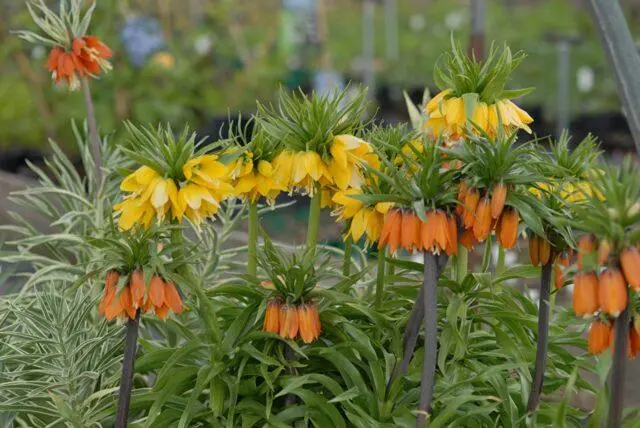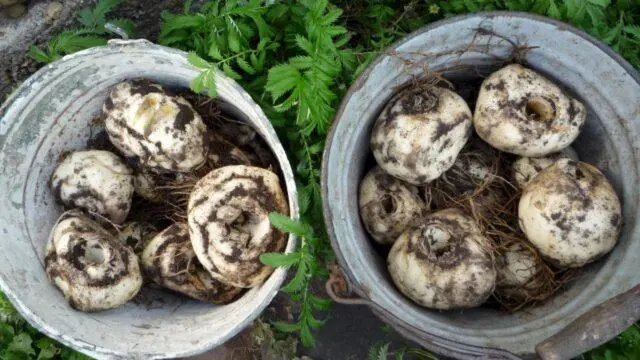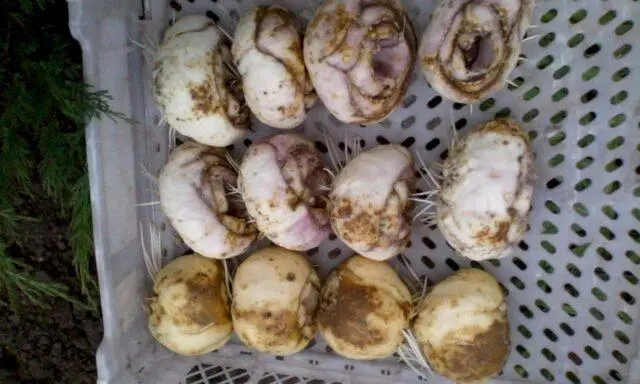Contents
Fritillaries after flowering require certain care, including a set of measures. It also includes digging up bulbs with subsequent storage until a new planting. Some gardeners resort to this measure annually, others – at certain intervals.
The hazel grouse has faded, what to do next
When caring for flowers with hazel grouse after flowering, it is first determined whether seeds are needed. If you plan to collect them, then wait for maturation. In this case, the aerial part of the plant is not touched. The disadvantage of the option is that there will be no flowering for next summer.
If seed collection is not required, then after the perennial buds wither, flower stalks are cut off. In order for the bulb to form better, potassium-phosphorus top dressing is done. Superphosphate and potassium sulfate are added per 1 m², 10-15 g each.
Fertilizers after flowering can be used in dry form, but be sure to combine top dressing with watering. Additionally, such preparation improves the protective functions of the plant.
If after the flowering of the perennial there is still a dry period, then even when the aerial part dies off, watering is continued. It is enough to moisten the soil every 2-3 weeks.
In addition to all of the above activities, after the flowering of the hazel grouse, the aerial part is cut off when it dries up, and the bulbs are dug up. Some gardeners refuse the last measure.

Digging up a perennial does not mean the need for a transplant – it can be returned to its original place
Do I need to dig up hazel grouse after flowering every year
It is not necessary to dig up hazel grouse every year after flowering. If a variety with small bulbs, then you can grow it in one place for several years. Seating will be needed only when the bushes thicken.
Digging of imperial hazel grouse is recommended every year. Otherwise, the bulbs of the plant will shrink, and therefore the flowering will not be so lush.
Perennial digging is allowed and once every two years. This is especially appropriate when children are needed. Due to their small size, they are easy to damage or lose when digging. It is better not to touch such bulbs for 1-2 years, and to prevent diseases and pests, ensure proper care, treatment with fungicides and insecticides.
When deciding how often to dig up grouse after flowering, you need to understand the benefits of this action. When the bulbs are at rest, they are more susceptible to disease and pest damage. Their digging, subsequent processing and proper storage reduces the risk of such problems. This is especially important for large bulbs like imperial hazel grouse.
Another important reason to dig up a perennial after flowering is the gradual deepening of the rhizome into the ground. This increases the germination time at the beginning of the season, increasing the risk of rotting.
Digging up a perennial after flowering is necessary when a transplant is required. If there are diseased plants or signs of rot, then it is effective to treat the vacated area with suitable preparations.

In the bulbs of hazel grouse dug out after flowering, a hole is visible – an escape with buds came out from here, sprouts will appear here by autumn
Digging after flowering is also necessary for perennial propagation. From an adult bulb, you can get several substitutes. This option is better than propagation by seeds, since you do not have to wait long for the first flowering.
When and how to prune hazel grouse after flowering
Harvest hazel grouse after flowering is not necessary immediately. First, only shoots with wilted buds are cut. This is done so that the plant after flowering does not spend on them the nutrients that are necessary for the bulbs.
The next pruning is carried out when the aerial part dries. At the same time, the location of the bulbs must be marked with pegs if they are dug up later. It is recommended to leave a stump about 5-10 cm high from the stem. This will facilitate the work when digging the underground part. Marking the location on the surface is then not required.
When pruning, it is important to remember about personal protection. Many types of hazel grouse are poisonous, can cause skin irritation, an allergic reaction.
Another important measure when pruning is the disinfection of the tool. It is better to process it after each plant. It is convenient to soak a small sponge or rag with alcohol or other disinfectant.
When to dig hazel grouse bulbs after flowering
The timing of digging hazel grouse after flowering depends on the specific variety, the climate in the growing region. You need to focus on the state of the aerial part of the plant. It is this that indicates that the bulbs have gone into a dormant state. This is evidenced by the fall of the petals after flowering, the yellowing of the green parts of the plant.
Another sign of the hibernation period is the drying of the perennial roots. This can be checked by carefully digging up the soil near the hazel grouse.
Harvest time is usually June-July. It is not worth waiting for the complete drying of the aerial part of the imperial hazel grouse. Its large bulbs during dormancy without digging are more prone to rot.

Grouse bulbs exude an unpleasant odor – this should be taken into account when choosing a place for storage
Proper digging of hazel grouse
Perennial tubers are too fragile, so you need to dig them out after flowering very carefully. Work should be planned for dry days. The algorithm is this:
- Cut off the above-ground part, if it has not been done before.
- Step back from the rest of the stem or marking peg 15-25 cm to the sides, carefully dig the soil. It is better to use a pitchfork instead of a shovel for this.
- Pull the bulb out of the ground, holding on to the bottom of the stem.
- Carefully clean the removed tubers.
- With a deep shovel, check the soil for the presence of separated children.
Even with all precautions, there is a risk of accidental damage to the bulbs. You should not throw them away if part of the bottom is saved – they will not die if properly processed and stored. Sprouts will appear next year.
The upper shell is removed from the hazel grouse bulbs, and then carefully examined. If there is rot or signs of a fungal disease, the affected area is cut off to healthy tissues, capturing them a little. Be sure to decontaminate these areas. You can use brilliant green or iodine.
How and where to store grouse bulbs before planting
To save hazel grouse bulbs until the next planting, they must first be properly prepared. In addition to cleaning the affected areas and disinfecting the sections, this implies the following measures:
- Drying. The dug hazel grouses are laid out in a warm and well-ventilated place without access to sunlight. The process takes about a week. The first 2-4 hours the tubers can be dried in the sun.
- Separation of roots and dried stem. This should be done carefully, this will form a hole.
- Disinfection. A solution of a fungicide preparation (Fitosporin is effective) or potassium permanganate (0,2 mg per 1 liter of water) is prepared, the tubers are immersed in it for half an hour. Such treatment is the prevention of diseases.
- Drying.
To store hazel grouse dug after flowering, choose a dry place with good ventilation. Optimum temperature from 25 °C. Cellars and cellars are not suitable for this.

Proper temperature and low humidity are important for the preservation of bulbs and the formation of flower buds.
Dug, processed and well-dried grouse are laid out in suitable containers:
- boxes made of wood or plastic;
- cardboard boxes.
In the selected container, hazel grouse bulbs are recommended to be laid out so that they do not touch each other. If the bottom of the containers is not perforated, then it is better to fill it with dry river sand. Its layer will improve the safety of the material, absorb excess moisture.
When the stem is removed, the hole in the tuber turns out to be through or funnel-shaped. The first option is more attractive, since the absence of a partition prevents moisture from accumulating inside. Such tubers can be placed upside down. If, after removing the stem, the hole turned out to be blind, then the bulbs are laid slightly to one side. Otherwise, moisture will accumulate inside, which is fraught with decay.
Grouse during storage must be systematically inspected. This is especially important when traces of rot were found and cleaned during cleaning.

When new roots and sprouts appear, the hazel grouses are ready for planting in open ground.
Conditions change if it is not planned to plant the perennial back into open ground in the same season. Then the material must be saved until next year. The room for him is chosen dry, but already cool. If there are few tubers, then you can place them in the refrigerator. The bulbs are stored in a container filled with wet peat.
Conclusion
After flowering, hazel grouses are dug up for protection against diseases and pests, reproduction. Tubers must be disinfected and dried, kept dry and warm. The shelf life is short, since in the same year the perennial is again planted in open ground.









